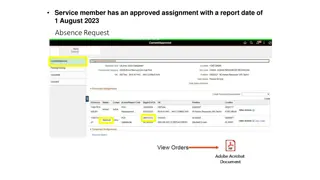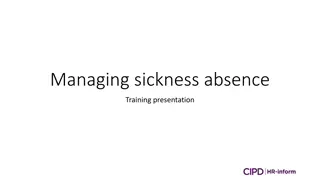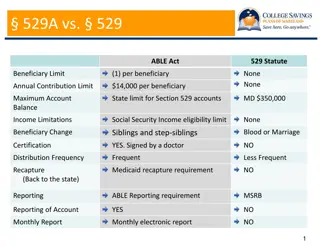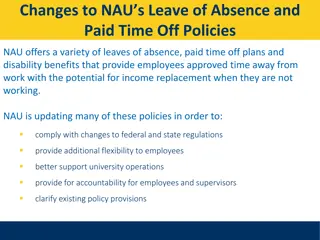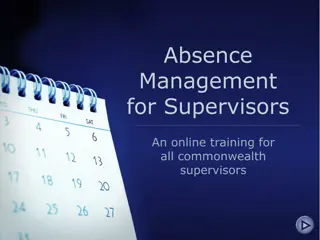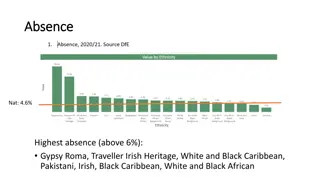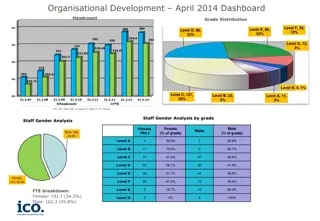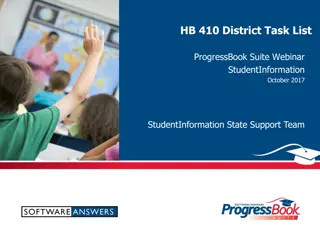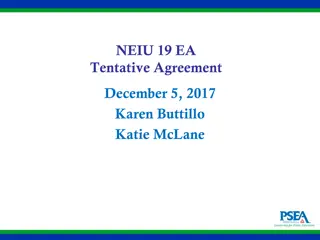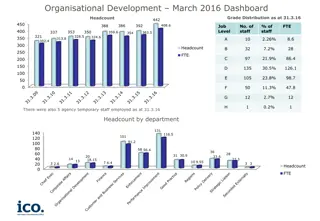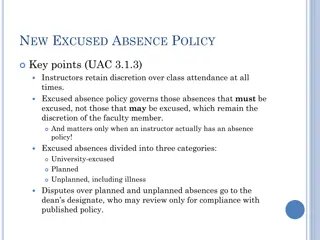
Managing Employee Absences: Balancing Obligations and Wellbeing
Delve into the history and evolution of workplace rights, explore strategies for dealing with absences at work, and understand the crucial principles of balancing employer-employee obligations. Learn how to navigate intermittent and long-term absences, chronic conditions, and other reasons for employee time off effectively.
Download Presentation

Please find below an Image/Link to download the presentation.
The content on the website is provided AS IS for your information and personal use only. It may not be sold, licensed, or shared on other websites without obtaining consent from the author. If you encounter any issues during the download, it is possible that the publisher has removed the file from their server.
You are allowed to download the files provided on this website for personal or commercial use, subject to the condition that they are used lawfully. All files are the property of their respective owners.
The content on the website is provided AS IS for your information and personal use only. It may not be sold, licensed, or shared on other websites without obtaining consent from the author.
E N D
Presentation Transcript
Staff Absence Management- Wisdom and Wellbeing for all An ABLE Conference Workshop Chris Whitmore CEO The Schools People chris@schoolspeople.co.uk
Purpose today Delve (briefly) into some history Share some wisdom on dealing with ill health and other absences at work Balance employer-employee obligations Work for the best, prepare for the worst
A little history- juridification and the place of rights at work 50s/60s: workplace issues principally resolved collectively 60s/70s: conflict becomes a crisis , individual rights expand and flourish 60s: contracts of employment (Act 1963), redundancy payments (Act 1965) 70s: familiar concepts are born- unfair dismissal (IRA 1971), grievances, redundancy consultation, various heads of discrimination 1974 Enter the Health and Safety at Work Etc. Act
Welfare at Work- that missing Etc. Statutory duties sit on top of and parallel to common law duties Thanks to King Aelfred Balancing obligations (s1 & s7)
Balancing obligations- a quick detour to worst case scenario Capability and fair dismissals- including for intermittent absences Dismissal fairness tests apply plus the How much longer? question BS vs Dundee Council: how much linger, consultation, prognosis (NB not OH report) O Brien vs Bolton St Catherine s Academy: return to work prognosis and the how much longer question
Balancing obligations- key principles Understanding goals Consistency Flexibility for individuals (tension) Procedural approaches which make sense
Balancing obligations- the difference-makers Intermittent absences Long-term absences Chronic conditions at work Absences for other reasons
Balancing obligations- the difference-makers Intermittent absences Proactivity- including communications Agreed actions after each absence Review of agreed actions Maximum resources available (wellbeing packages etc.)
Balancing obligations- the difference-makers Long-term absences Proactivity- including communications Agreed actions during absence Review of agreed actions /negotiation of pivot points Maximum resources available (wellbeing packages etc.)- cost the alternatives
Balancing obligations- the difference-makers Long-term absences: Stress Proactivity- day one issue Agreed actions during absence- identify stressors asap Propose solutions, propose GP review of them Review of agreed actions during absence /negotiation of pivot points Maximum resources available (wellbeing packages etc.)- cost the alternatives
Balancing obligations- the difference-makers Chronic conditions at work (Equality Act cases) Maximise Reasonable Adjustments (trial periods if necessary) Negotiate maximum attendance, quality/quantity of work Maximum resources available (wellbeing packages etc.)- cost the alternatives
Balancing obligations- the difference-makers Absences for other reasons Open dialogue about the reasons (including those hidden) Maximise Reasonable Adjustments if temporary (trial periods if necessary) Negotiate maximum attendance, quality/quantity of work and period Maximum resources available (wellbeing packages etc.)- cost the alternatives
Balancing obligations- key resources You, your knowledge and networks Wellbeing resources OH provision- BUT Key is asking the right questions- & needing a clinical opinion Creativity
Key takeaways Focus on goals and the achievable Consistency vs creativity If the policy doesn t work- change it Negotiate actions and review them If unsure- take advice
chris@schoolspeople.co.uk 07966 006090


